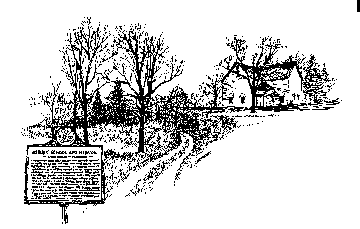Fort Mitchell was built by the Georgia militia in 1813 during the Creek War on the main Indian trade route to the Tombigbee River. It was the trading post for the southeast from 1817 to 1820, and a military post until 1840.
In September 1821, the South Carolina Annual Conference sent the Rev. William Capers to Fort Mitchell as “missionary in South Carolina and to the Indians.” After negotiations with the chiefs of the Creek Nations, he opened the Asbury Manual Labor School and Mission in 1822 to teach Creek children reading, writing, and other “civilized” skills.
The mission was one mile north of Fort Mitchell near the Indian village of Coweta and may have been the first formal educational effort in the Chattahoochee Valley. The school opened with twelve pupils under the direction of Rev. Isaac Smith. Throughout its history, the school had, on average, 35 to 50 students. There were soon three teachers, several buildings, and a farm of about 25 acres. The school closed in 1830 with the forced removal to Oklahoma of much of the Creek tribe.
William Capers (1790-1855) was a native of South Carolina. He was the Superintendent of the Asbury Mission from 1821 to 1824, and during most of this time was also pastor of the Milledgeville, Georgia station. In 1829 he began a mission to slaves in the Charleston district, and later was Superintendent of slave missions on islands off the Georgia coast. Capers was elected Bishop of the Methodist Episcopal Church, South at its first General Conference in 1846. He died at Anderson, South Carolina on January 29, 1855.
Isaac Smith (1758-1834) was a Revolutionary War veteran who crossed the Delaware with Washington. He was General Lafayette’s aide near the end of the Revolution. He was converted by Francis Asbury, and is considered one of the founders of Methodism in South Carolina. In 1796 he left the ministry and became a businessman in Camden, South Carolina.
In 1820, at the age of 62, Smith re-entered the ministry, and the following year was named a presiding elder in Athens, Georgia. He was dubbed the “St. John of the South Georgia Conference.” Smith served the Asbury Manual Labor School until his retirement from the ministry in 1827, at the age of 69. He died seven years later at his daughter’s home in Marion County, Georgia.
Points of interest at this Heritage Landmark: None of the school or mission buildings still stands, but an historical marker near the site gives a brief summary of its history. Fort Mitchell’s foundations may be seen, along with the fort’s burial grounds and the area where the Crowell Trading Post and the Agent’s home were located. (Col. Crowell was the U.S. Agent for Indian Affairs and was opposed to the school and mission. He was Alabama’s only Territorial Delegate and its first member of Congress, and is buried in the fort’s cemetery.) Members of the Crowell family are buried at nearby Alexander United Methodist Church. The church was probably founded as a direct result of the Asbury Mission.
Special events: None as of this writing.
Area attractions: In the area are the National Infantry Museum, Fort Benning, Georgia; the Confederate Naval Museum and the Columbus Museum, Columbus, Georgia; and the Little White House Historic Site, Warm Springs, Georgia. The Fort Mitchell Veterans’ Cemetery has services on Memorial Day and Veterans’ Day.
To visit: The marker is at the entrance to Fort Mitchell Park and is accessible during daylight hours. The original location is now privately owned property. With permission, the owners will allow a visit. To obtain permission, contact Sharon Tucker (see address below).
Location: Within the boundaries of the Alabama-West Florida Annual Conference in Russell County, Alabama. The site is one mile west of the Chattahoochee river and six miles south of Phenix City, Alabama and Columbus, Georgia.
Food and lodging: Restaurants and motels are available in Phenix City and Columbus.
Directions: From Phenix City, take U.S. Route 431 south about five miles, then turn left on State Route 165, proceeding about eight miles to Fort Mitchell. The Fort Mitchell gates are on the left as you travel south just beyond Mount Olive High School. The marker is at the entrance to Fort Mitchell Park, adjacent to the Southeast Veterans Cemetery maintained by the Department of Veterans’ Affairs.
For further information, contact: Sharon Tucker, Conference Archivist, Alabama-West Florida Annual Conference Archives, Methodist Archives Center, Huntingdon College Library, 1500 E. Fairview Ave., Montgomery, AL 36106-2148; 334-833-4413 (b); E-mail: stucker@hawks.huntingdon.edu.
To learn more about United Methodist history in this area: Alabama-West Florida Annual Conference Archives, Methodist Archives Center, Huntingdon College Library, 1500 E. Fairview Ave., Montgomery, AL 36106-2148; 334-833-4413 (b); E-mail: stucker@hawks.huntingdon.edu; Sharon Tucker, Archivist.
Marion Elias Lazenby, History of Methodism in Alabama and West Florida (Nashville(?), 1960).
Anson West, A History of Methodism in Alabama (Spartanburg, SC: The Reprint Company, 1983; originally published, Nashville: Publishing House, Methodist Episcopal Church, South, 1893).

